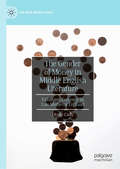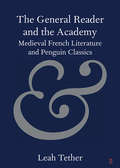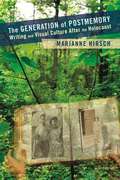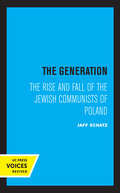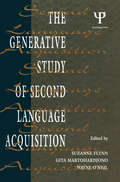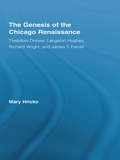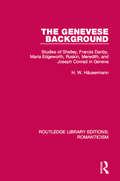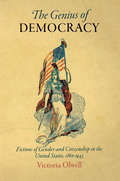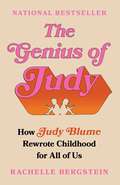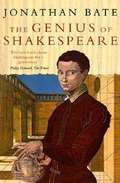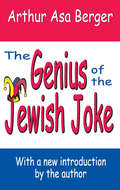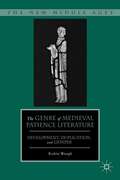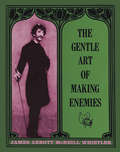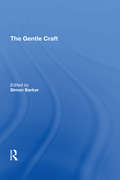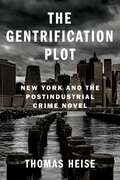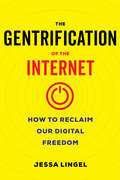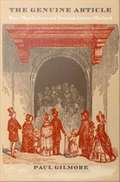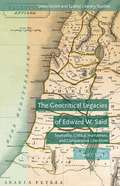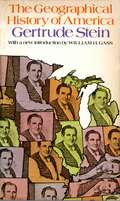- Table View
- List View
The Gender of Modernity
by Rita FelskiIn an innovative and invigorating exploration of the complex relations between women and the modern, Rita Felski challenges conventional male-centered theories of modernity. She also calls into question those feminist perspectives that have either demonized the modern as inherently patriarchal, or else assumed a simple opposition between men’s and women’s experiences of the modern world. Combining cultural history with cultural theory, and focusing on the fin de siècle, Felski examines the gendered meanings of such notions as nostalgia, consumption, feminine writing, the popular sublime, evolution, revolution, and perversion. Her approach is comparative and interdisciplinary, covering a wide variety of texts from the English, French, and German traditions: sociological theory, realist and naturalist novels, decadent literature, political essays and speeches, sexological discourse, and sentimental popular fiction. Male and female writers from Simmel, Zola, Sacher-Masoch, and Rachilde to Marie Corelli, Wilde, and Olive Schreiner come under Felski’s scrutiny as she exposes the varied and often contradictory connections between femininity and modernity. Seen through the lens of Felski’s discerning eye, the last fin de siècle provides illuminating parallels with our own. And Felski’s keen analysis of the matrix of modernism offers needed insight into the sense of cultural crisis brought on by postmodernism.
The Gender of Money in Middle English Literature: Value and Economy in Late Medieval England (The New Middle Ages)
by Diane CadyThe Gender of Money in Middle English Literature: Value and Economy in Late Medieval England explores the vital and under-examined role that gender plays in the conceptualization of money and value in a period that precedes and shapes what we now recognize as the discipline of political economy. Through readings of a range of late Middle English texts, this book demonstrates the ways in which gender ideology provided a vocabulary for articulating fears and fantasies about money and value in the late Middle Ages. These ideas inform beliefs about money and value in the West, particularly in realms that are often seen as outside the sphere of economy, such as friendship, love and poetry. Exploring the gender of money helps us to better understand late medieval notions of economy, and to recognize the ways in which gender ideology continues to haunt our understanding of money and value, albeit often in occluded ways.
The General Reader and the Academy: Medieval French Literature and Penguin Classics (Elements in Publishing and Book Culture)
by Leah TetherPenguin Classics have built their reputation as one of the largest and most successful modern imprints for 'classic' texts on the notion of 'the general reader'. Following an interrogation of this idea, Leah Tether investigates the publication of medieval French literature on this list and shines a light on the drivers, motivations, negotiations and decision-making processes behind it. Focusing on the medieval French texts published between c.1956 and 2000, Tether demonstrates that, rather than Penguin's frequently cited 'general reader', a more academic market may have contributed to ensuring the success of these titles.
The Generation of Postmemory: Writing and Visual Culture After the Holocaust
by Marianne HirschA multifaceted encounter with foundational and cutting-edge theories in memory, trauma, gender, and visual culture, eliciting a new understanding of history and our place in it.
The Generation of Postmemory: Writing and Visual Culture After the Holocaust (Gender and Culture Series)
by Marianne HirschCan we remember other people's memories? The Generation of Postmemory argues we can: that memories of traumatic events live on to mark the lives of those who were not there to experience them. Children of survivors and their contemporaries inherit catastrophic histories not through direct recollection but through haunting postmemories-multiply mediated images, objects, stories, behaviors, and affects passed down within the family and the culture at large. In these new and revised critical readings of the literary and visual legacies of the Holocaust and other, related sites of memory, Marianne Hirsch builds on her influential concept of postmemory. The book's chapters, two of which were written collaboratively with the historian Leo Spitzer, engage the work of postgeneration artists and writers such as Art Spiegelman, W.G. Sebald, Eva Hoffman, Tatana Kellner, Muriel Hasbun, Anne Karpff, Lily Brett, Lorie Novak, David Levinthal, Nancy Spero and Susan Meiselas. Grappling with the ethics of empathy and identification, these artists attempt to forge a creative postmemorial aesthetic that reanimates the past without appropriating it. In her analyses of their fractured texts, Hirsch locates the roots of the familial and affiliative practices of postmemory in feminism and other movements for social change. Using feminist critical strategies to connect past and present, words and images, and memory and gender, she brings the entangled strands of disparate traumatic histories into more intimate contact. With more than fifty illustrations, her text enables a multifaceted encounter with foundational and cutting edge theories in memory, trauma, gender, and visual culture, eliciting a new understanding of history and our place in it.
The Generation: The Rise and Fall of the Jewish Communists of Poland (Society and Culture in East-Central Europe #5)
by Jaff SchatzThis title is part of UC Press's Voices Revived program, which commemorates University of California Press’s mission to seek out and cultivate the brightest minds and give them voice, reach, and impact. Drawing on a backlist dating to 1893, Voices Revived makes high-quality, peer-reviewed scholarship accessible once again using print-on-demand technology. This title was originally published in 1991.
The Generative Study of Second Language Acquisition
by Suzanne Flynn Gita Martohardjono Wayne O'NeilThe vast majority of work in theoretical linguistics from a generative perspective is based on first language acquisition and performance. The vast majority of work on second language acquisition is carried out by scholars and educators working within approaches other than that of generative linguistics. In this volume, this gap is bridged as leading generative linguists apply their intellectual and disciplinary skills to issues in second language acquisition. The results will be of interest to all those who study second language acquisition, regardless of their theoretical perspective, and all generative linguists, regardless of the topics on which they work.
The Genesis of the Chicago Renaissance: Theodore Dreiser, Langston Hughes, Richard Wright, and James T. Farrell (Literary Criticism and Cultural Theory)
by Mary HrickoThis study examines the genesis of Chicago's two identified literary renaissance periods (1890-1920 and 1930-1950) through the writings of Dreiser, Hughes, Wright, and Farrell. The relationship of these four writers demonstrates a continuity of thought between the two renaissance periods. By noting the affinities of these writers, patterns such as the rise of the city novel, the development of urban realism, and the shift to modernism are identified as significant connections between the two periods. Although Dreiser, Wright, and Farrell are more commonly thought of as Chicago writers, this study argues that Langston Hughes is a transitional, pivotal figure between the two periods. Through close readings and contextualization, the influence of Chicago writing on American literature--in such areas as realism and naturalism, as well as proletarian and ethnic fiction--becomes apparent.
The Genevese Background: Studies of Shelley, Francis Danby, Maria Edgeworth, Ruskin, Meredith, and Joseph Conrad in Geneva (Routledge Library Editions: Romanticism)
by H. W. HäusermannFirst published in 1952. This title explores the lives of authors during their time in Geneva; including chapters on the Romantic author Mary Shelley, the novelist Joseph Conrad and the critic John Ruskin, amongst many others. This interesting study also includes letters that had previously been unpublished, all of which provide an insightful introduction into the lives of the writers. The Genevese Background will be of interest to students of literature.
The Genius of Democracy: Fictions of Gender and Citizenship in the United States, 1860-1945
by Victoria OlwellIn the late nineteenth- and early twentieth-century United States, ideas of genius did more than define artistic and intellectual originality. They also provided a means for conceptualizing women's participation in a democracy that marginalized them. Widely distributed across print media but reaching their fullest development in literary fiction, tropes of female genius figured types of subjectivity and forms of collective experience that were capable of overcoming the existing constraints on political life. The connections between genius, gender, and citizenship were important not only to contests over such practical goals as women's suffrage but also to those over national membership, cultural identity, and means of political transformation more generally.In The Genius of Democracy Victoria Olwell uncovers the political uses of genius, challenging our dominant narratives of gendered citizenship. She shows how American fiction catalyzed political models of female genius, especially in the work of Louisa May Alcott, Henry James, Mary Hunter Austin, Jessie Fauset, and Gertrude Stein. From an American Romanticism that saw genius as the ability to mediate individual desire and collective purpose to later scientific paradigms that understood it as a pathological individual deviation that nevertheless produced cultural progress, ideas of genius provided a rich language for contests over women's citizenship. Feminist narratives of female genius projected desires for a modern public life open to new participants and new kinds of collaboration, even as philosophical and scientific ideas of intelligence and creativity could often disclose troubling and more regressive dimensions. Elucidating how ideas of genius facilitated debates about political agency, gendered identity, the nature of consciousness, intellectual property, race, and national culture, Olwell reveals oppositional ways of imagining women's citizenship, ways that were critical of the conceptual limits of American democracy as usual.
The Genius of Judy: How Judy Blume Rewrote Childhood for All of Us
by Rachelle BergsteinNATIONAL BESTSELLER An intimate and expansive look at Judy Blume&’s life, work, and cultural impact, focusing on her most iconic—and controversial—young adult novels, from Are You There God? It&’s Me, Margaret. to Blubber.Everyone knows Judy Blume. Her books have garnered her fans of all ages for decades and sold tens of millions of copies. But why were people so drawn to them? And why are we still talking about them now in the 21st century? In The Genius of Judy, her remarkable story is revealed as never before, beginning with her as a mother of two searching for purpose outside of her home in 1960s suburban New Jersey. The books she wrote starred regular children with genuine thoughts and problems. But behind those deceptively simple tales, Blume explored the pillars of the growing women&’s rights movement, in which girls and women were entitled to careers, bodily autonomy, fulfilling relationships, and even sexual pleasure. Blume wasn&’t trying to be a revolutionary—she just wanted to tell honest stories—but in doing so, she created a cohesive, culture-altering vision of modern adolescence. Blume&’s bravery provoked backlash, making her the country&’s most-banned author in the mid-1980s. Thankfully, her works withstood those culture wars and it&’s no coincidence that Blume has resurfaced as a cultural touchstone now. Young girls are still cat-called, sex education curricula are getting dismissed as pornography, and entire shelves of libraries are being banned. As we face these challenges, it&’s only natural we look to Blume, the grand dame of so-called dirty books. This is the story of how a housewife became a groundbreaking artist, and how generations of empowered fans are her legacy, today more than ever.
The Genius of Language: Fifteen Writers Reflect on Their Mother Tongues
by Wendy LesserWendy Lesser--a celebrated essayist in her own right--has put together a rich and often surprising work, a book brimming with pleasures for lovers of literature, travel, memoir, and, above all, language.
The Genius of Shakespeare
by Jonathan BateThis fascinating book by one of Britain's most acclaimed young Shakespeare scholars explores the extraordinary staying-power of Shakespeare's work. Bate opens by taking up questions of authorship, asking, for example, Who was Shakespeare, based on the little documentary evidence we have? Which works really are attributable to him? And how extensive was the influence of Christopher Marlowe? Bate goes on to trace Shakespeare's canonization and near-deification, examining not only the uniqueness of his status among English-speaking readers but also his effect on literate cultures across the globe. Ambitious, wide-ranging, and historically rich, this book shapes a provocative inquiry into the nature of genius as it ponders the legacy of a talent unequaled in English letters. A bold and meticulous work of scholarship, The Genius of Shakespeare is also lively and accessibly written and will appeal to any reader who has marveled at the Bard and the enduring power of his work.
The Genius of the Jewish Joke
by Arthur Asa BergerThe Genius of the Jewish Joke focuses on what is distinctive and unusual about Jewish jokes and Jewish humor. Jewish humor is humor by Jews and about Jews, in whatever medium this humor is found. Jokes are defined as short stories, meant to amuse, with a punch line, though Jewish humor exists in many other forms—riddles, comic definitions, parodies—as well. The book makes a "radical" suggestion about the origin of Jewish humor—namely, that Sarah and Abraham's relation to God, and the name of their son Isaac (which, in Hebrew, means laughter), recognizes a special affinity in Jews for humor. Abraham does not sacrifice Isaac (humor) and, thus, humor and the Jews are linked early in Jewish history.Berger discusses techniques of humor and how they can be used to analyze jokes. He also compares "Old World Jewish Humor"—the humor of the shtetl, with its fabulous schlemiels, schlimazels, schnorrers, and other characters—and "New World Humor"—the humor of Jewish doctors, lawyers, accountants, and other professional types living mostly in the suburbs nowadays. Jewish humor is contrasted with other forms of ethnic humor, such as Polish jokes and Italian American jokes.This humor, in addition to providing pleasure, reveals a great deal about Jewish character and culture and, in addition, the human condition. Now available with a new introduction by the author, The Genius of the Jewish Joke is an entertaining and informative inquiry into Jewish humor that explores its distinctiveness, its unique spirit, and its role in Jewish identity.
The Genocidal Gaze: From German Southwest Africa to the Third Reich
by Elizabeth R. BaerThe first genocide of the twentieth century, though not well known, was committed by Germans between 1904–1907 in the country we know today as Namibia, where they exterminated thousands of Herero and Nama people and subjected the surviving indigenous men, women, and children to forced labor. The perception of Africans as subhuman—lacking any kind of civilization, history, or meaningful religion—and the resulting justification for the violence against them is what author Elizabeth R. Baer refers to as the “genocidal gaze,” an attitude that was later perpetuated by the Nazis. In The Genocidal Gaze: From German Southwest Africa to the Third Reich, Baer uses the trope of the gaze to trace linkages between the genocide of the Herero and Nama and that of the victims of the Holocaust. Significantly, Baer also considers the African gaze of resistance returned by the indigenous people and their leaders upon the German imperialists. Baer explores the threads of shared ideology in the Herero and Nama genocide and the Holocaust—concepts such as racial hierarchies, lebensraum (living space), rassenschande (racial shame), and endlösung (final solution) that were deployed by German authorities in 1904 and again in the 1930s and 1940s to justify genocide. She also notes the use of shared methodology—concentration camps, death camps, intentional starvation, rape, indiscriminate killing of women and children—in both instances. While previous scholars have made these links between the Herero and Nama genocide and that of the Holocaust, Baer’s book is the first to examine literary texts that demonstrate this connection. Texts under consideration include the archive of Nama revolutionary Hendrik Witbooi; a colonial novel by German Gustav Frenssen (1906), in which the genocidal gaze conveyed an acceptance of racial annihilation; and three post-Holocaust texts—by German Uwe Timm, Ghanaian Ama Ata Aidoo, and installation artist William Kentridge of South Africa—that critique the genocidal gaze. Baer posits that writing and reading about the gaze is an act of mediation, a power dynamic that calls those who commit genocide to account for their crimes and discloses their malignant convictions. Careful reading of texts and attention to the narrative deployment of the genocidal gaze—or the resistance to it—establishes discursive similarities in books written both during colonialism and in the post-Holocaust era. The Genocidal Gaze is an original and challenging discussion of such contemporary issues as colonial practices, the Nazi concentration camp state, European and African race relations, definitions of genocide, and postcolonial theory. Moreover, Baer demonstrates the power of literary and artistic works to condone, or even promote, genocide or to soundly condemn it. Her transnational analysis provides the groundwork for future studies of links between imperialism and genocide, links among genocides, and the devastating impact of the genocidal gaze.
The Genre of Acts and Collected Biography
by Sean A. AdamsIt is widely accepted by New Testament scholars that the Gospel of Luke and the Acts of the Apostles probably originated as two parts of one work by a single author. In spite of this, the books have been assigned to very different genres: Luke is traditionally viewed as a biography of Jesus, and Acts as a history of the early church. Comparing in detail the structure and content of Acts with the formal features of history, novel, epic and biography, Sean Adams challenges this division. Applying both ancient and modern genre theory, he argues that the best genre parallel for the Acts of the Apostles is in fact collected biography. Offering a nuanced and sophisticated understanding of genre theory, along with an insightful argument regarding the composition and purpose of Acts, this book will be of interest to those studying the New Testament, Acts, genre theory and ancient literature.
The Genre of Medieval Patience Literature
by Robin WaughThis book examines evolution of medieval patience literature from a focus on male and female sufferers to a focus on female suffers in particular. Using feminist revisions of genre-theory, Waugh analyses the concept of counterfeit consciousness in the works of Margery Kempe and Chaucer among others.
The Gentle Art of Making Enemies
by James M. WhistlerWhistler's Gentle Art, a classic in the literature of insult and denigration, might well be subtitled "The Autobiography of a Hater," for it contains the deadly sarcasm and stinging remarks of one of the wittiest men of the nineteenth century. Whistler not only refused to tolerate misunderstanding by critics and the so-called art-loving public -- but launched vicious counterattacks as well. His celebrated passages-at-arms with Oscar Wilde and Swinburne, the terse and penetrating "letters to the editor," his rebuttals to attacks from critics, and biting marginal notes to contemptuous comments on his paintings and hostile reviews (which are also reprinted) are all part of this record of the artist's vendettas.Whistler's most famous battle began when critic John Ruskin saw one of the artist's "Nocturnes" exhibited in Grosvenor Gallery. "I have seen, and heard," wrote Ruskin, "much of cockney impudence before now; but never expected to hear a coxcomb ask two hundred guineas for flinging a pot of paint in the public's face." Whistler was incensed with this criticism, and initiated the famous libel case "Whistler vs. Ruskin." Extracts from the resultant trial record are among the highlights of this book, with Whistler brilliantly annihilating his Philistine critics, but winning only a farthing in damages.The Gentle Art, designed by Whistler himself, is a highly entertaining account of personal revenges, but it is also an iconoclast's plea for a new and better attitude toward painting. As a historical document, it is the best statement of the new aesthetics versus the old guard academics, and it helped greatly in shaping the modern feeling toward art.
The Gentle Art of Verbal Self-Defense
by Suzette Haden ElginDon't turn the other cheek and fume quietly; know what to say when someone throws out the snide backhanded "compliment," subtle insult, cruel criticism, or outright verbal blow.
The Gentle Craft: By Thomas Deloney (Non-canonical Early Modern Popular Texts)
by Simon BarkerAlthough it was probably conceived as a trilogy, only the first two parts of Thomas Deloney's prose romance were completed, dealing with the origins of the shoemaker's trade and how it succeeded in London. The Gentle Craft is best known as the principal source of Thomas Dekker's The Shoemaker's Holiday. But Deloney's tale of Simon Eyre, who founded Leadenhall, the centre of the leather trade, and rose to be Lord Mayor of London, is itself significant for its adaptation of euphemistic romances and jestbooks. In this volume the author offers in modern typography, with explanatory notes and an extensive introduction, an account of the sources and influence of the book, its publication history and what is known of its author. He suggests that Deloney's combination of romance with the practical morality of an emerging social class produced a text that is uniquely important for those interested in late-Elizabethan popular culture.
The Gentrification Plot: New York and the Postindustrial Crime Novel (Literature Now)
by Thomas HeiseFor decades, crime novelists have set their stories in New York City, a place long famed for decay, danger, and intrigue. What happens when the mean streets of the city are no longer quite so mean? In the wake of an unprecedented drop in crime in the 1990s and the real-estate development boom in the early 2000s, a new suspect is on the scene: gentrification. Thomas Heise identifies and investigates the emerging “gentrification plot” in contemporary crime fiction. He considers recent novels that depict the sweeping transformations of five iconic neighborhoods—the Lower East Side, Chinatown, Red Hook, Harlem, and Bedford-Stuyvesant—that have been central to African American, Latinx, immigrant, and blue-collar life in the city. Heise reads works by Richard Price, Henry Chang, Gabriel Cohen, Reggie Nadelson, Ivy Pochoda, Grace Edwards, Ernesto Quiñonez, Wil Medearis, and Brian Platzer, tracking their representations of “broken-windows” policing, cultural erasure, racial conflict, class grievance, and displacement. Placing their novels in conversation with oral histories, urban planning, and policing theory, he explores crime fiction’s contradictory and ambivalent portrayals of the postindustrial city’s dizzying metamorphoses while underscoring the material conditions of the genre. A timely and powerful book, The Gentrification Plot reveals how today’s crime writers narrate the death—or murder—of a place and a way of life.
The Gentrification of the Internet: How to Reclaim Our Digital Freedom
by Jessa LingelHow we lost control of the internet—and how to win it back. The internet has become a battleground. Although it was unlikely to live up to the hype and hopes of the 1990s, only the most skeptical cynics could have predicted the World Wide Web as we know it today: commercial, isolating, and full of, even fueled by, bias. This was not inevitable. The Gentrification of the Internet argues that much like our cities, the internet has become gentrified, dominated by the interests of business and capital rather than the interests of the people who use it. Jessa Lingel uses the politics and debates of gentrification to diagnose the massive, systemic problems blighting our contemporary internet: erosions of privacy and individual ownership, small businesses wiped out by wealthy corporations, the ubiquitous paywall. But there are still steps we can take to reclaim the heady possibilities of the early internet. Lingel outlines actions that internet activists and everyday users can take to defend and secure more protections for the individual and to carve out more spaces of freedom for the people—not businesses—online.
The Genuine Article: Race, Mass Culture, and American Literary Manhood
by Paul GilmoreIn The Genuine Article Paul Gilmore examines the interdependence of literary and mass culture at a crucial moment in U. S. history. Demonstrating from a new perspective the centrality of race to the construction of white manhood across class lines, Gilmore argues that in the years before the Civil War, as literature increasingly became another commodity in the capitalist cultural marketplace, American authors appropriated middle-brow and racially loaded cultural forms to bolster their masculinity. From characters in Indian melodramas and minstrel shows to exhibits in popular museums and daguerrotype galleries, primitive racialized figures circulated as "the genuine article" of manliness in the antebellum United States. Gilmore argues that these figures were manipulated, translated, and adopted not only by canonical authors such as Hawthorne, Thoreau, Cooper, and Melville but also by African American and Native American writers like William Wells Brown and Okah Tubbee. By examining how these cultural notions of race played out in literary texts and helped to construct authorship as a masculine profession, Gilmore makes a unique contribution to theories of class formation in nineteenth-century America. The Genuine Article will enrich students and scholars of American studies, gender studies, literature, history, sociology, anthropology, popular culture, and race.
The Geocritical Legacies of Edward W. Said
by Robert T. Tally Jr.Edward W. Said is considered one of the most influential literary and postcolonial theorists in the world. Affirming Said's multifaceted and enormous critical impact, this collection features essays that highlight the significance of Said's work for contemporary spatial criticism, comparative literary studies, and the humanities in general.
The Geographical History of America: or the Relation of Human Nature to the Human Mind
by Gertrude Stein"First published in 1936 and long out of print, The Geographical History of America brings together prose pieces, dialogues, philosophical meditations, and playlets by one of the century's most influential experimental writers. This short but brilliant book offers a dimension of Gertrude Stein's thinking not available elsewhere. Here Stein sets forth her view of the human mind: what it is, how it works, and how it is different from - and more interesting than - human nature. " "Geographical History also elaborates on Stein's concepts of identity, landscape, presence, and composition. Today, as literary discourse pays more attention to textuality, to voice, reader-response, and phenomenology, Stein emerges as a pioneering modernist to whom the century is slowly catching up. For those in the performing arts, Geographical History further addresses the notion of play as landscape, one of Stein's most influential theatrical ideas, as well as such issues as dialogue, character, and dramatic structure - in a book that is itself a model of modern experimentation. "--BOOK JACKET. Title Summary field provided by Blackwell North America, Inc. All Rights Reserved

